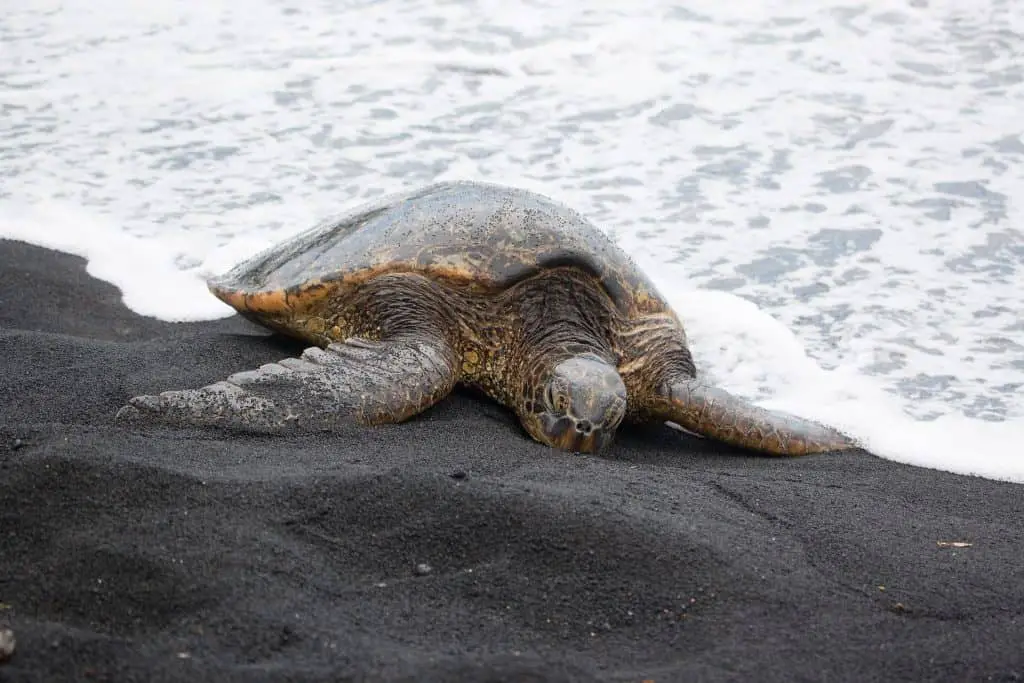Turtles are cold-blooded creatures, meaning their body temperature is dependent on the environment around them. During winter, when temperatures drop too low for turtles to survive, they must find a way to stay warm and safe until spring arrives.
Freshwater turtles for example have adopted an ingenious method of surviving the winter months: Hibernating in the mud at the bottom of ponds where temperatures never dip below 1°C. In this state which is also known as Brumation, turtles remain conscious but their metabolism slows down drastically so that they can survive without food or oxygen for several months.
Turtles cannot breathe underwater so instead, they do some respiration near their throat and tail which allows them to get enough oxygen to keep going during this time.
Where Do Turtles Go in the Winter?
In the winter, turtles hibernate. This can simply mean they find a quiet spot and slow down their heartbeat and breathing until spring arrives. Depending on the species of turtle, they may burrow into mud or debris to protect themselves from the cold or travel to warmer waters.
Some species migrate seasonally in order to find food or warmer temperatures. No matter where they go, turtles will return when the weather becomes warm again.

Hibernation
Turtles are cold-blooded reptiles, meaning they rely on the environment to regulate their body temperature. During the winter, when temperatures drop, turtles will go into a state of hibernation. This is known as brumation and helps them survive the cold weather.
Hibernation typically occurs from October to April in most areas but can vary depending on the location and species of turtle. During this time, turtles will burrow into mud or sand at the bottom of a pond or lake and remain there until spring arrives.
While in hibernation, turtles slow down their metabolism significantly which allows them to conserve energy during these colder months when food sources may be scarce.
During hibernation, it’s important that water levels remain consistent so that turtles don’t become exposed while they are sleeping below ground level. If water levels decrease too much then it could leave some parts of the pond uncovered which would cause dehydration for any animals still submerged in mud or sand beneath it.
It’s also important that ponds do not freeze over completely during this time as this could lead to suffocation if a turtle becomes trapped underneath ice with no access to air pockets above ground level.
Hibernation is a common strategy for turtles to survive the winter season, but some species of turtles also migrate to warmer climates during this time. Now let’s look at migration as another way that turtles prepare for the cold weather.
Migration
Migration is a common behavior among turtles, especially aquatic species. Turtles may travel hundreds of miles to find suitable climates during the winter months. For example, some sea turtles migrate from colder waters in the north to warmer areas in the south for hibernation and breeding purposes.
Turtles can sense changes in temperature and light levels that signal when it’s time to start their journey. They use landmarks like coastlines or mountain ranges as navigational aids while they travel long distances over land or sea. During migration, turtles must be careful not to get lost or become dehydrated due to a lack of food and water sources along their route.
The exact distance traveled by migrating turtles varies greatly depending on species and location; however, some have been known to traverse thousands of miles each year. For instance, loggerhead sea turtles are known for traveling more than 3,000 miles from Japan’s Pacific Coast all the way down to Mexico’s Baja California Peninsula every year.
In addition to traveling long distances for hibernation purposes, many turtle species also migrate seasonally between feeding grounds and nesting sites. This type of migration is especially important for female turtles who need access to both types of habitats throughout their reproductive cycle so they can lay eggs safely away from predators while still having enough energy reserves left over after laying eggs in order to feed themselves properly afterward.
Overall, migration is an essential part of a turtle’s life cycle that helps them survive harsh weather conditions as well as provides them with the necessary resources needed for reproduction purposes. By understanding how these creatures move around our planet we can better protect them against threats such as habitat destruction which could prevent them from reaching their destination safely each year.
Migration is a natural behavior of turtles in the winter months, allowing them to find more suitable habitats. Next we’ll explore how aquatic turtles handle the cold season.
Hibernation Vs. Brumation For Turtles
Hibernation and brumation are two terms that are often used interchangeably, but they have distinct differences. Hibernation is a state of dormancy that mammals enter during the winter months in order to conserve energy. During this time, their body temperature drops significantly and their metabolic rate slows down drastically. Brumation is similar to hibernation but it is only experienced by reptiles such as turtles.
Unlike mammals, reptiles do not generate body heat so their bodies remain at the same temperature as the environment around them. As a result, when temperatures drop during winter months they become dormant instead of entering into a deep sleep as mammals do during hibernation.
They will still wake up on warmer days in order to search for food or water but unlike hibernating animals, they can be easily woken up if disturbed due to being in an inactive state rather than asleep.
Brumating animals also tend to stay active longer than those who hibernate because they don’t need to store up energy for long periods of time like some species of mammal do before going into hibernation mode. This means that you may see turtles out wandering around even on colder days while other animals may already be sleeping through the winter season until spring arrives again.
Overall, both processes serve important functions for different types of animals; allowing them to survive cold weather conditions without expending too much energy or risking starvation from lack of resources available during these times of the year.
While there are similarities between brumation and hibernation, understanding the subtle differences between these two states can help us better appreciate how unique each animal’s adaptation strategies really are!
Key Takeaway 💭
Turtles rely on the environment to survive in winter by entering a state of brumation. This involves burrowing into mud or sand at the bottom of a pond, slowing down their metabolism and conserving energy. To ensure their safety during hibernation, water levels must remain consistent and ponds should not freeze over completely.
How Turtles Breath While Brumating
Turtles have a unique ability to survive the cold winter months, known as brumation. During this time, turtles are able to slow down their metabolism and conserve energy by reducing their activity levels. But how do they breathe while in this state?
The answer lies in a process called “cloacal respiration”. This is where turtles use the same opening that they pass waste and eggs out of for gas exchange across blood vessels. With minimal energetic needs due to matching water temperatures outside, oxygen from the water is usually enough for them during brumation.
However, sometimes there isn’t enough oxygen available in the water which can lead to too little oxygen being supplied to the turtle’s body. In these cases, turtles switch over to anaerobic respiration – meaning they don’t need any oxygen at all! Although not ideal, it allows them to survive until spring when more sun-bathing opportunities arise and lactic acid buildup decreases again.
It’s unclear why some turtles choose certain spots over others for brumating but what we do know is that without this ability many species would be unable to survive through winter months with no way of generating heat on their own!
How Long Does a Turtle Brumate?
Turtles brumate for different lengths of time depending on their location and the season. Generally, turtles in colder climates will spend more time brumating than those in warmer areas. Additionally, springtime can vary from year to year, so the length of a turtle’s brumation period may differ as well.
Most turtles are able to stay in brumation for up to 8 months each year. However, many won’t need that much time; some may only require a few weeks or even days of hibernation before they emerge again.
When it comes to determining how long your pet turtle should be spending in its winter slumber, there are several factors you should consider first. The temperature of the water is key: if it’s too cold (below 50°F), then your turtle might not wake up at all! On the other hand, if it’s too warm (above 70°F) then your pet could become overly active during its hibernation period and use up valuable energy reserves which would otherwise be saved for when it emerges again come springtime.
The amount of food available is also important – if there isn’t enough food around during winter months then your turtle might not have enough energy stored away to make it through until spring arrives again! Lastly, pay attention to any changes in behavior that occur over this period.
if you notice anything unusual or out-of-the-ordinary with regard to eating habits or activity levels then take action immediately as this could indicate something wrong with your pet’s health or environment that needs addressing right away!
While most turtles can safely remain dormant for up 8 months per year without any issues arising – ultimately how long yours spends in its winter sleep depends on various environmental factors such as temperature and food availability – so always keep an eye out for any signs that something isn’t quite right with either one!
You May Also Read 📖
Hibernating without Oxygen: Physiological Adaptations of the Painted Turtle by Donald C Jackson
How Do Turtles Know When to Wake Up?
Turtles don’t have an internal clock that tells them when to wake up. Instead, their activity level is determined by the temperature of the water they live in. When it gets cold, their metabolism slows down and they become less active. As the weather warms up, their metabolism increases and they become more active.
This means that turtles can be seen swimming around underwater during winter on warmer days as long as there isn’t ice on top of the water’s surface. However, these periods of activity are usually shorter than those during spring or summer since colder temperatures slow down a turtle’s metabolism again quickly.
When spring arrives and temperatures start to rise steadily, turtles will remain more active for longer periods of time until autumn comes around again and temperatures drop once more. This cycle repeats itself year after year with no need for an alarm clock!
Can Turtles Survive in Snow?
Turtles are well-equipped to survive in cold temperatures, including snow. They can handle the chillier weather by slowing down their metabolism and lying on the bottom of a pond or lake. This helps them stay warm and conserve energy until spring arrives.
Wild turtles will often prepare for winter months ahead of time by finding food sources that will last them through the colder season. They may also dig into mud or sand at the bottom of a body of water to keep themselves insulated from extreme temperatures above ground.
Pet turtles, however, don’t have this same ability to prepare for winter as wild turtles do since they don’t experience natural changes in temperature and lighting throughout the year. Therefore, pet owners should never put their pets out in the snow as it could be fatal for them due to a lack of preparation and insulation from cold temperatures.
If you see a turtle out in the snow while walking around your neighborhood, chances are it knows what it is doing! Turtles have evolved over thousands of years with an instinctive understanding of how best to survive during different seasons – so if you spot one outside when there’s snow on the ground then rest assured that it has found its own way to cope with chilly conditions!
That being said, seeing a turtle out in snowy weather is still quite rare – so if you ever come across one then make sure not to disturb it too much as this could stress out your reptilian friend even more than necessary!
FAQs
Can turtles survive being frozen?
Yes, turtles can survive being frozen. In fact, some species of turtles are able to hibernate in the winter by burying themselves in mud or leaf litter and entering a state of dormancy known as brumation. During this time their body temperature drops significantly and they become almost completely immobile.
This process is similar to freezing, but it allows them to survive until warmer temperatures return. Other species may migrate south for the winter where they will remain active until springtime when they return home again.
Can turtles live in a pond during winter?
Yes, turtles can live in a pond during winter. However, the type of turtle and the climate of the area will determine how successful they are at surviving cold temperatures. In areas with mild winters, many species of aquatic turtles may remain active year-round and can be seen swimming or basking on logs or rocks when air temperatures are above freezing.
In colder climates, most species will hibernate underwater for several months until water temperatures rise again in the springtime. During this time, it is important to ensure that your pond does not freeze over completely as this could lead to suffocation for any hibernating turtles inside.
Are turtles active in the winter?
Generally, some turtles are active in the winter. Turtles can be seen swimming and basking on sunny days even when temperatures drop below freezing. They may slow down their activity during cold snaps, but they don’t fully hibernate as some other animals do.
During the winter months, turtles will often seek out areas with warmer water or air temperatures to stay warm and conserve energy. To survive the cold weather, turtles also rely on food stores that they have built up over the summer months.
Conclusion
In conclusion, turtles have a variety of strategies for surviving the winter. Some hibernate (Brumation), some migrate, and others stay active if they are kept indoors during cold weather.
No matter where they go to survive the winter months, it is important to remember that all turtles need special care and attention when temperatures drop. Knowing where turtles go in the winter can help ensure that your pet turtle remains safe and healthy throughout the season!




Leave a Reply